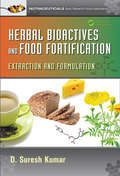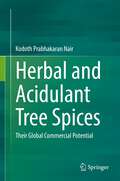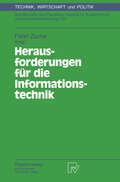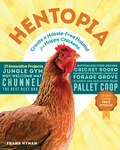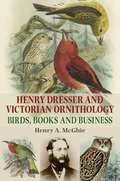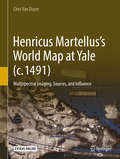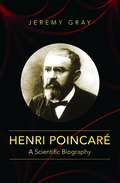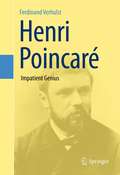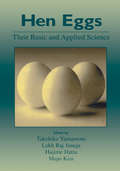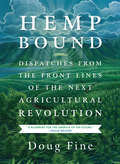- Table View
- List View
Herbal Bioactives and Food Fortification: Extraction and Formulation (Nutraceuticals Ser.)
by D. Suresh KumarRecent major shifts in global health care management policy have been instrumental in renewing interest in herbal medicine. However, literature on the development of products from herbs is often scattered and narrow in scope. Herbal Bioactives and Food Fortification: Extraction and Formulation provides information on all aspects of the extraction o
Herbal Bioactives and Food Fortification: Extraction and Formulation (Nutraceuticals Ser. #4)
by D. Suresh KumarRecent major shifts in global health care management policy have been instrumental in renewing interest in herbal medicine. However, literature on the development of products from herbs is often scattered and narrow in scope. Herbal Bioactives and Food Fortification: Extraction and Formulation provides information on all aspects of the extraction o
Herbal and Acidulant Tree Spices: Their Global Commercial Potential
by Kodoth Prabhakaran NairThis book discusses leafy spices or herbs known as “aromatic herbs”, which, apart from being used in culinary art for flavoring of foods and beverages, are also known to possess antiseptic, anti-oxidant and other medicinal properties, in addition to many nutraceutical and cosmetic properties. Of the numerous herbs twelve of the commercially important herbs are imported into 4 major European markets, namely, France, Germany, United Kingdom and The Netherlands to the tune of 12000 to 13000 tonnes per annum. This book discusses these leafy herbs and their tremendous commercial potential in international trade. The book offers a comprehensive insight into commercial herbs, with an objective of enhancing their yield, and provides a platform for further research into the global trade potential.
Herausforderungen für die Informationstechnik: Internationale Konferenz in Dresden, 15. – 17. Juni 1993 (Technik, Wirtschaft und Politik #7)
by Peter ZocheDie Herausforderungen für die Informationstechnik waren Gegenstand einer internationalen Konferenz, die im Juni 1993 in Dresden stattfand. In diesem Band wird ein repräsentativer Querschnitt der Konferenzbeiträge vorgelegt. Es werden die Anforderungen an die Informationstechnik aus Sicht der Wirtschaft, Politik und Kultur dargestellt. Die Informationstechnik ist eine Schlüsseltechnologie, die Gegenwart und Zukunft bestimmt. Sie ist Grundlage für die Entwicklung der Industrieländer innerhalb der internationalen Konkurrenzbeziehungen. Die Einsatzmöglichkeiten und Wirkungen neuer Informations- und Kommunikationstechniken sind jedoch widersprüchlich und werden kontrovers diskutiert. Mit den Chancen und Risiken dieser Techniken befassen sich die Beiträge des Konferenzberichtes.
Herausforderung Utility 4.0: Wie sich die Energiewirtschaft im Zeitalter der Digitalisierung verändert
by Oliver D. DoleskiDas Buch begleitet den Übergang von der analogen zur digitalen Energiewirtschaft und gibt dem Leser wertvolle Impulse für die Erschließung neuer, lukrativer Betätigungsfelder. Autoren aus Wissenschaft und Praxis liefern ausgewählte Antworten auf die enormen Herausforderungen angesichts von Digitalisierung und Dezentralisierung im Energiesektor. Insofern soll das Buch Mut machen, die digitale Transformation zügig anzugehen und den Veränderungsprozess insgesamt als Chance zu begreifen. Die Debatte um die Ausgestaltung und Zukunft von Utility 4.0 hat damit gerade erst begonnen.
Her Last Lie
by Amanda Brittany‘An exciting new voice – Brittany reels readers in with this twisty, clever thriller that will have you second-guessing everything…’ Phoebe Morgan, author of The Doll House ‘Brilliant, pacey, and will leave you suspecting everyone is involved!’ Darren O’Sullivan, author of Our Little Secret
Hepatitis A Virus in Food: Detection and Inactivation Methods (SpringerBriefs in Food, Health, and Nutrition)
by Glòria SánchezHepatitis A virus (HAV) is responsible for around half of the total number of hepatitis infections diagnosed worldwide. HAV infection is mainly propagated via the fecal-oral route, and as a consequence of globalization, transnational outbreaks of foodborne infections are reported with increasing frequency. Therefore, in this review, state-of-the-art information on the molecular procedures for HAV detection in food, and the efficacy of common food manufacturing processes are compiled. The purpose of this Brief is to consolidate basic information on various aspects of HAV and to provide a guideline for its prevention and control across the food supply chain from pre-harvest to manufacturing.
Hepatitis E Virus: An Emerging Zoonotic and Foodborne Pathogen (SpringerBriefs in Food, Health, and Nutrition)
by Franco Maria Ruggeri Ilaria Di Bartolo Fabio Ostanello Marcello TrevisaniHepatitis E (HEV) is a viral infectious disease that infects humans and domestic, wild, and synanthropic animals alike. In developing countries, the disease often presents as an epidemic, transmitted primarily through the fecal-oral route. In recent years, sporadic cases have also been documented in industrial countries, including Europe. The identification and characterization of animal strains of HEV from pigs, wild boar, and deer, and the demonstrated ability of cross-species infection by these animal strains raise potential public health concerns for foodborne and zoonotic transmission of the virus. This Brief will provide a thorough overview of HEV. It will discuss the epidemiology and pathogenesis of the virus in both humans and animals, review detection methods, and provide methods for its control and prevention.
Hentopia: Create a Hassle-Free Habitat for Happy Chickens; 21 Innovative Projects
by Frank HymanTake more pleasure in owning a backyard flock with low-cost, imaginative projects that reduce chores, solve common problems, and benefit chickens and chicken-keepers alike, from a predator-proof chicken run to a self-filling waterer, automatic coop doors, and more.
Henry Dresser and Victorian ornithology: Birds, books and business
by Henry A. McGhieThis book explores the life of Henry Dresser (1838–1915), one of the most productive British ornithologists of the mid-late nineteenth and early twentieth centuries. The author examines how Dresser and his contemporaries discovered and documented birds across the globe.
Henry Dresser and Victorian ornithology: Birds, books and business
by Henry A. McGhieThis book explores the life of Henry Dresser (1838–1915), one of the most productive British ornithologists of the mid-late nineteenth and early twentieth centuries. The author examines how Dresser and his contemporaries discovered and documented birds across the globe.
Henricus Martellus’s World Map at Yale: Multispectral Imaging, Sources, and Influence (c. #1491)
by Chet Van DuzerThis book presents groundbreaking new research on a fifteenth-century world map by Henricus Martellus, c. 1491, now at Yale. The importance of the map had long been suspected, but it was essentially unstudiable because the texts on it had faded to illegibility. Multispectral imaging of the map, performed with NEH support in 2014, rendered its texts legible for the first time, leading to renewed study of the map by the author. This volume provides transcriptions, translations, and commentary on the Latin texts on the map, particularly their sources, as well as the place names in several regions. This leads to a demonstration of a very close relationship between the Martellus map and Martin Waldseemüller’s famous map of 1507. One of the most exciting discoveries on the map is in the hinterlands of southern Africa. The information there comes from African sources; the map is thus a unique and supremely important document regarding African cartography in the fifteenth century. This book is essential reading for digital humanitarians and historians of cartography.
Henri Poincaré: A Scientific Biography
by Jeremy GrayHenri Poincaré (1854-1912) was not just one of the most inventive, versatile, and productive mathematicians of all time--he was also a leading physicist who almost won a Nobel Prize for physics and a prominent philosopher of science whose fresh and surprising essays are still in print a century later. The first in-depth and comprehensive look at his many accomplishments, Henri Poincaré explores all the fields that Poincaré touched, the debates sparked by his original investigations, and how his discoveries still contribute to society today. Math historian Jeremy Gray shows that Poincaré's influence was wide-ranging and permanent. His novel interpretation of non-Euclidean geometry challenged contemporary ideas about space, stirred heated discussion, and led to flourishing research. His work in topology began the modern study of the subject, recently highlighted by the successful resolution of the famous Poincaré conjecture. And Poincaré's reformulation of celestial mechanics and discovery of chaotic motion started the modern theory of dynamical systems. In physics, his insights on the Lorentz group preceded Einstein's, and he was the first to indicate that space and time might be fundamentally atomic. Poincaré the public intellectual did not shy away from scientific controversy, and he defended mathematics against the attacks of logicians such as Bertrand Russell, opposed the views of Catholic apologists, and served as an expert witness in probability for the notorious Dreyfus case that polarized France. Richly informed by letters and documents, Henri Poincaré demonstrates how one man's work revolutionized math, science, and the greater world.
Henri Poincaré: A Scientific Biography
by Jeremy GrayA comprehensive look at the mathematics, physics, and philosophy of Henri PoincaréHenri Poincaré (1854–1912) was not just one of the most inventive, versatile, and productive mathematicians of all time—he was also a leading physicist who almost won a Nobel Prize for physics and a prominent philosopher of science whose fresh and surprising essays are still in print a century later. The first in-depth and comprehensive look at his many accomplishments, Henri Poincaré explores all the fields that Poincaré touched, the debates sparked by his original investigations, and how his discoveries still contribute to society today.Math historian Jeremy Gray shows that Poincaré's influence was wide-ranging and permanent. His novel interpretation of non-Euclidean geometry challenged contemporary ideas about space, stirred heated discussion, and led to flourishing research. His work in topology began the modern study of the subject, recently highlighted by the successful resolution of the famous Poincaré conjecture. And Poincaré's reformulation of celestial mechanics and discovery of chaotic motion started the modern theory of dynamical systems. In physics, his insights on the Lorentz group preceded Einstein's, and he was the first to indicate that space and time might be fundamentally atomic. Poincaré the public intellectual did not shy away from scientific controversy, and he defended mathematics against the attacks of logicians such as Bertrand Russell, opposed the views of Catholic apologists, and served as an expert witness in probability for the notorious Dreyfus case that polarized France.Richly informed by letters and documents, Henri Poincaré demonstrates how one man's work revolutionized math, science, and the greater world.
Henri Poincaré: Impatient Genius
by Ferdinand VerhulstThe book describes the life of Henri Poincaré, his work style and in detail most of his unique achievements in mathematics and physics. Apart from biographical details, attention is given to Poincaré's contributions to automorphic functions, differential equations and dynamical systems, celestial mechanics, mathematical physics in particular the theory of the electron and relativity, topology (analysis situs). A chapter on philosophy explains Poincaré's conventionalism in mathematics and his view of conventionalism in physics; the latter has a very different character. In the foundations of mathematics his position is between intuitionism and axiomatics.One of the purposes of the book is to show how Poincaré reached his fundamentally new results in many different fields, how he thought and how one should read him. One of the new aspects is the description of two large fields of his attention: dynamical systems as presented in his book on `new methods for celestial mechanics' and his theoretical physics papers. At the same time it will be made clear how analysis and geometry are intertwined in Poincaré's thinking and work.In dynamical systems this becomes clear in his description of invariant manifolds, his association of differential equation flow with mappings and his fixed points theory. There is no comparable book on Poincaré, presenting such a relatively complete vision of his life and achievements. There exist some older biographies in the French language, but they pay only restricted attention to his actual work. The reader can obtain from this book many insights in the working of a very original mind while at the same time learning about fundamental results for modern science
Henkeeping: Inspiration And Practical Advice For Would-be Smallholders (Countryside Ser.)
by Jane EastoeChickens are back in style with a vengeance: poultry breeders are struggling to cope with the increase in demand and gardens resound to the contented cluck of chickens.
Hendrik Adriaan Van Reed Tot Drakestein 1636-1691 and Hortus, Malabaricus
by J. HenigerThis text is a reference work for botanists studying the flora of South Asia. As commander of Malabar, van Reed was responsible for compiling the Hortus Malabaricus, a major publication of the flora and medical use of plants.
Hendrik Adriaan Van Reed Tot Drakestein 1636-1691 and Hortus, Malabaricus
by J. HenigerThis text is a reference work for botanists studying the flora of South Asia. As commander of Malabar, van Reed was responsible for compiling the Hortus Malabaricus, a major publication of the flora and medical use of plants.
Hen Eggs: Basic and Applied Science
by Takehiko Yamamoto Lekh Raj Juneja Hajime Hatta Mujo KimThe egg is a chemical storehouse-within an incubating egg a complicated set of chemical reactions take place that convert the chemicals into a living animal. Using hen eggs as a model, this new text explores the use of eggs for food, industrial, and pharmaceutical applications. It covers the chemistry, biology, and function of lipids; carbohydrates; proteins; yolk antibody (IgY); and other materials of eggs. The novel merits of egg materials over others used in the same products are also discussed. These areas of egg technology have never been compiled before in one source.
Hen Eggs: Basic and Applied Science
by Takehiko Yamamoto Lekh Raj Juneja Hajime Hatta Mujo KimThe egg is a chemical storehouse-within an incubating egg a complicated set of chemical reactions take place that convert the chemicals into a living animal. Using hen eggs as a model, this new text explores the use of eggs for food, industrial, and pharmaceutical applications. It covers the chemistry, biology, and function of lipids; carbohydrates; proteins; yolk antibody (IgY); and other materials of eggs. The novel merits of egg materials over others used in the same products are also discussed. These areas of egg technology have never been compiled before in one source.
HEMT Technology and Applications (Springer Tracts in Electrical and Electronics Engineering)
by Trupti Ranjan Lenka Hieu Pham Trung NguyenThis book covers two broad domains: state-of-the-art research in GaN HEMT and Ga2O3 HEMT. Each technology covers materials system, band engineering, modeling and simulations, fabrication techniques, and emerging applications. The book presents basic operation principles of HEMT, types of HEMT structures, and semiconductor device physics to understand the device behavior. The book presents numerical modeling of the device and TCAD simulations for high-frequency and high-power applications. The chapters include device characteristics of HEMT including 2DEG density, Id-Vgs, Id-Vds, transconductance, linearity, and C-V. The book emphasizes the state-of-the-art fabrication techniques of HEMT and circuit design for various applications in low noise amplifier, oscillator, power electronics, and biosensor applications. The book focuses on HEMT applications to meet the ever-increasing demands of the industry, innovation in terms of materials, design, modeling, simulation, processes, and circuits. The book will be primarily helpful to undergraduate/postgraduate, researchers, and practitioners in their research.
The Hempcrete Book: Designing and building with hemp-lime (Sustainable Building #5)
by William Stanwix Alex SparrowA comprehensive practical manual for professionals and self-builders, this innovative book explains the many benefits of building with hempcrete. Hempcrete is a building material with excellent, environmentally friendly properties. It's made from lime and hemp shivs (a waste product from hemp fibre growing) and can be used for walks, floor and roof insulation. Hempcrete is breathable, absorbing and emitting moisture; this helps regulate internal humidity, avoiding trapped moisture and mould growth, and creating healthier buildings. It provides excellent acoustic and thermal insulation, and it is lightweight, which reduces construction costs. Whether you're working on a new build or are planning a renovation, The Hempcrete Book tells you everything you need to know to get started with hempcrete. It describes how to source and mix it, and provides a detailed account of construction techniques, highlighting potential pitfalls and how to avoid them. With fully illustrated design notes and examples of completed builds, this book is a powerful tool for any eco-builder.
Hemp Bound: Dispatches from the Front Lines of the Next Agricultural Revolution
by Doug FineThe stat sheet on hemp sounds almost too good to be true: its fibers are among the planet’s strongest, its seed oil the most nutritious, and its potential as an energy source vast and untapped. Its one downside? For nearly a century, it’s been illegal to grow industrial cannabis in the United States–even though Betsy Ross wove the nation’s first flag out of hemp fabric, Thomas Jefferson composed the Declaration of Independence on it, and colonists could pay their taxes with it. But as the prohibition on hemp’s psychoactive cousin winds down, one of humanity’s longest-utilized plants is about to be reincorporated into the American economy. Get ready for the newest billion-dollar industry. In Hemp Bound:Dispatches from the Front Lines of the Next Agricultural Revolution, bestselling author Doug Fine embarks on a humorous yet rigorous journey to meet the men and women who are testing, researching, and pioneering hemp’s applications for the twenty-first century. From Denver, where Fine hitches a ride in a hemp-powered limo; to Asheville, North Carolina, where carbon-negative hempcrete-insulated houses are sparking a mini housing boom; to Manitoba where he raps his knuckles on the hood of a hemp tractor; and finally to the fields of east Colorado, where practical farmers are looking toward hemp to restore their agricultural economy—Fine learns how eminently possible it is for this misunderstood plant to help us end dependence on fossil fuels, heal farm soils damaged after a century of growing monocultures, and bring even more taxable revenue into the economy than its smokable relative. Fine’s journey will not only leave you wondering why we ever stopped cultivating this miracle crop, it will fire you up to sow a field of it for yourself, for the nation’s economy, and for the planet.
Hemp and Sustainability (Sustainable Textiles: Production, Processing, Manufacturing & Chemistry)
by Fieke Dhondt Subramanian Senthilkannan MuthuThis book highlights the positive and negative impacts that hemp fibre and textiles have on environment, while studying the effects of climate change on the growth of fibre hemp. Human-induced climate change challenge the availability of textile fibres, whereas today’s apparel industry leaves behind a substantial environmental footprint. Sustainable hemp textiles can lighten it. The book describes the environmental impact of hemp and how climate change influences future hemp growth. Hemp is considered in most literature as a sustainable alternative for the commonly used fibres polyester and cotton. However, most research does not go farther than the environmental impacts of hemp, and there is currently a lack of knowledge/literature that examines the possibilities of hemp growth under changing climate conditions.
Hemp: Industrial Production and Uses
by Pierre BoulocHemp production for industrial purposes continues to grow worldwide, and is currently being used for many applications including house insulation, paper making, animal bedding, fabric, rope making and also as a biofuel. This book brings together international experts to examine all aspects of industrial hemp production, including the origins of hemp production, as well as the botany and anatomy, genetics and breeding, quality assessment, regulations, and the agricultural and industrial economics of hemp production. A translation of Le Chanvre Industriel, this book has been revised and updated for an international audience and is essential reading for Producers of industrial hemp, industry personnel and agriculture researchers and students.
